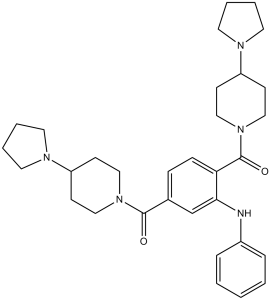UNC1215
This product is for research use only, not for human use. We do not sell to patients.

For small sizes, please check our retail website as below: www.invivochem.com
| Size | Price | Stock |
|---|---|---|
| 250mg | $750 | Check With Us |
| 500mg | $1250 | Check With Us |
| 1g | $1875 | Check With Us |
Cat #: V0427 CAS #: 1415800-43-9 Purity ≥ 98%
Description: UNC1215 (UNC-1215) is a potent and selective antagonist of L3MBTL3, a member of the MBT (malignant brain tumor) family of methyllysine (Kme) reading domain, with potential antineoplastic activity.
Top Publications Citing Invivochem Products
Publications Citing InvivoChem Products
Product Promise

- Physicochemical and Storage Information
- Protocol
- Related Biological Data
- Stock Solution Preparation
- Quality Control Documentation
| Molecular Weight (MW) | 529.72 |
|---|---|
| Molecular Formula | C32H43N5O2 |
| CAS No. | 1415800-43-9 |
| Storage | -20℃ for 3 years in powder formr |
| -80℃ for 2 years in solvent | |
| Solubility In Vitro | DMSO: 100 mg/mL (188.7 mM)r |
| Water: <1 mg/mLr | |
| Ethanol: 100 mg/mL (188.7 mM) | |
| SMILES Code | O=C(C1=CC=C(C(N2CCC(N3CCCC3)CC2)=O)C=C1NC4=CC=CC=C4)N5CCC(N6CCCC6)CC5 |
| Synonyms | UNC-1215, UNC 1215, UNC1215 |
| Protocol | In Vitro | UNC1215 binds L3MBTL3 with a d of 120 nM, competitively displacing mono- or dimethyllysine-containing peptides, and is greater than 50-fold more potent toward L3MBTL3 than other members of the MBT family while also demonstrating selectivity against more than 200 other reader domains examined. X-ray crystallography identified a unique 2:2 polyvalent mode of interaction between UNC1215 and L3MBTL3. In cells, UNC1215 is nontoxic and directly binds L3MBTL3 via the Kme-binding pocket of the MBT domains. UNC1215 increases the cellular mobility of GFP-L3MBTL3 fusion proteins, and point mutants that disrupt the Kme-binding function of GFP-L3MBTL3 phenocopy the effects of UNC1215 on localization. |
|---|
These protocols are for reference only. InvivoChem does not
independently validate these methods.
| Solvent volume to be added | Mass (the weight of a compound) | |||
|---|---|---|---|---|
| Mother liquor concentration | 1mg | 5mg | 10mg | 20mg |
| 1mM | 1.8878 mL | 9.4389 mL | 18.8779 mL | 37.7558 mL |
| 5mM | 0.3776 mL | 1.8878 mL | 3.7756 mL | 7.5512 mL |
| 10mM | 0.1888 mL | 0.9439 mL | 1.8878 mL | 3.7756 mL |
| 20mM | 0.0944 mL | 0.4719 mL | 0.9439 mL | 1.8878 mL |
The molarity calculator equation
Mass(g) = Concentration(mol/L) × Volume(L) × Molecular Weight(g/mol)
Mass
=
Concentration
×
Volume
×
Molecular Weight*
The dilution calculator equation
Concentration(start)
×
Volume(start)
=
Concentration(final)
×
Volume(final)
This equation is commonly abbreviated as: C1 V1 = C2 V2
Concentration(start)
C1
×
Volume(start)
V1
=
Concentration(final)
C2
×
Volume(final)
V2
Step One: Enter information below
Dosage mg/kg
Average weight of animals g
Dosing volume per animal µL
Number of animals
Step Two: Enter the in vivo formulation
%DMSO
+
%
+
%Tween 80
+
%ddH2O
Calculation Results:
Working concentration:
mg/ml;
Method for preparing DMSO master liquid:
mg
drug pre-dissolved in
µL
DMSO(Master liquid concentration
mg/mL)
,Please contact us first if the concentration exceeds the DMSO solubility of the batch of drug.
Method for preparing in vivo formulation:
Take
µL
DMSO master liquid, next add
µL
PEG300, mix and clarify, next add
µL
Tween 80,mix and clarify, next add
µL
ddH2O,mix and clarify.
Note:
- (1) Please be sure that the solution is clear before the addition of next solvent. Dissolution methods like vortex, ultrasound or warming and heat may be used to aid dissolving.
- (2) Be sure to add the solvent(s) in order.




































